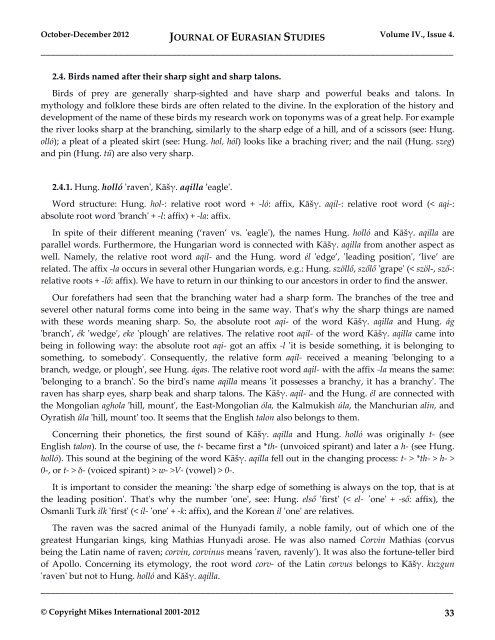Create successful ePaper yourself
Turn your PDF publications into a flip-book with our unique Google optimized e-Paper software.
October-December 2012 JOURNAL OF EURASIAN STUDIES Volume IV., Issue 4.<br />
_____________________________________________________________________________________<br />
2.4. Birds named after their sharp sight and sharp talons.<br />
Birds <strong>of</strong> prey are generally sharp-sighted and have sharp and powerful beaks and talons. In<br />
mythology and folklore these birds are <strong>of</strong>ten related to the divine. In the exploration <strong>of</strong> the history and<br />
development <strong>of</strong> the name <strong>of</strong> these birds my research work on toponyms was <strong>of</strong> a great help. For example<br />
the river looks sharp at the branching, similarly to the sharp edge <strong>of</strong> a hill, and <strong>of</strong> a scissors (see: Hung.<br />
olló); a pleat <strong>of</strong> a pleated skirt (see: Hung. hol, hól) looks like a braching river; and the nail (Hung. szeg)<br />
and pin (Hung. tű) are also very sharp.<br />
2.4.1. Hung. holló 'raven', Kāšγ. aqilla 'eagle'.<br />
Word structure: Hung. hol-: relative root word + -ló: affix, Kāšγ. aqil-: relative root word (< aqi-:<br />
absolute root word 'branch' + -l: affix) + -la: affix.<br />
In spite <strong>of</strong> their different meaning (‘raven’ vs. 'eagle'), the names Hung. holló and Kāšγ. aqilla are<br />
parallel words. Furthermore, the Hungarian word is connected with Kāšγ. aqilla from another aspect as<br />
well. Namely, the relative root word aqil- and the Hung. word él 'edge’, 'leading position', ‘live’ are<br />
related. The affix -la occurs in several other Hungarian words, e.g.: Hung. szöllő, szőlő 'grape' (< szöl-, sző-:<br />
relative roots + -lő: affix). We have to return in our thinking to our ancestors in order to find the answer.<br />
Our forefathers had seen that the branching water had a sharp form. The branches <strong>of</strong> the tree and<br />
severel other natural forms come into being in the same way. That's why the sharp things are named<br />
with these words meaning sharp. So, the absolute root aqi- <strong>of</strong> the word Kāšγ. aqilla and Hung. ág<br />
'branch', ék 'wedge', eke 'plough' are relatives. The relative root aqil- <strong>of</strong> the word Kāšγ. aqilla came into<br />
being in following way: the absolute root aqi- got an affix -l 'it is beside something, it is belonging to<br />
something, to somebody'. Consequently, the relative form aqil- received a meaning 'belonging to a<br />
branch, wedge, or plough', see Hung. ágas. The relative root word aqil- with the affix -la means the same:<br />
'belonging to a branch'. So the bird's name aqilla means 'it possesses a branchy, it has a branchy'. The<br />
raven has sharp eyes, sharp beak and sharp talons. The Kāšγ. aqil- and the Hung. él are connected with<br />
the Mongolian aghola 'hill, mount', the East-Mongolian óla, the Kalmukish úla, the Manchurian alin, and<br />
Oyratish ûla 'hill, mount' too. It seems that the English talon also belongs to them.<br />
Concerning their phonetics, the first sound <strong>of</strong> Kāšγ. aqilla and Hung. holló was originally t- (see<br />
English talon). In the course <strong>of</strong> use, the t- became first a *th- (unvoiced spirant) and later a h- (see Hung.<br />
holló). This sound at the begining <strong>of</strong> the word Kāšγ. aqilla fell out in the changing process: t- > *th- > h- ><br />
0-, or t- > δ- (voiced spirant) > w- >V- (vowel) > 0-.<br />
It is important to consider the meaning: 'the sharp edge <strong>of</strong> something is always on the top, that is at<br />
the leading position'. That's why the number 'one', see: Hung. első 'first' (< el- 'one' + -ső: affix), the<br />
Osmanli Turk ilk 'first' (< il- 'one' + -k: affix), and the Korean il 'one' are relatives.<br />
The raven was the sacred animal <strong>of</strong> the Hunyadi family, a noble family, out <strong>of</strong> which one <strong>of</strong> the<br />
greatest Hungarian kings, king Mathias Hunyadi arose. He was also named Corvin Mathias (corvus<br />
being the Latin name <strong>of</strong> raven; corvin, corvinus means 'raven, ravenly'). It was also the fortune-teller bird<br />
<strong>of</strong> Apollo. Concerning its etymology, the root word corv- <strong>of</strong> the Latin corvus belongs to Kāšγ. kuzgun<br />
'raven' but not to Hung. holló and Kāšγ. aqilla.<br />
_____________________________________________________________________________________<br />
© Copyright Mikes International 2001-2012 33

















